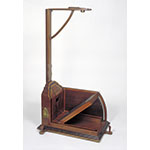The apparatus shows that, in elastic shocks, the angle of incidence is equal to the angle of reflection.
A rectangular box with a small opening is mounted on a wooden base, fitted with three leveling screws to ensure that the apparatus is perfectly horizontal. The box carries an arm on which is mounted a horizontal board with a brass-lined hole. On the base is hinged a wooden frame bearing a porphyry slab, whose slope can be adjusted from 0° to about 45°. An ivory ball dropped through the brass-lined hole bounces off the porphyry slab; if the latter is tilted at 45°, the ball is deflected in such a way as to fall exactly into the box opening.
In describing the apparatus in Leçons de physique expérimentale (Paris, 1743-1748), Jean-Antoine Nollet notes that, in the real-life experiment, the angles of incidence and reflection are never exactly equal. The reasons include the imperfect elasticity of the materials, air resistance, and the ball's slightly curved trajectory after the rebound. Provenance: Lorraine collections.










